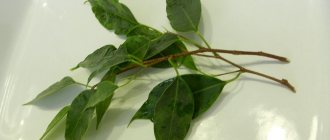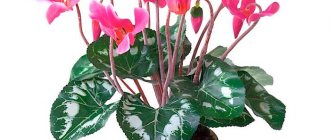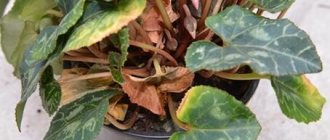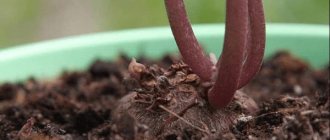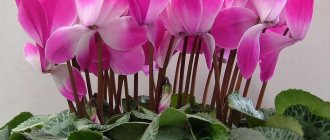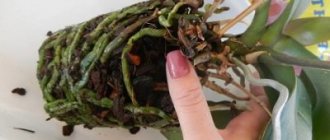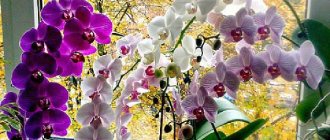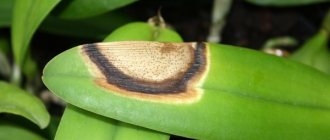Indoor cyclamen flower, description and photo
Cyclamen (another name for dryweed) is a perennial herbaceous representative of the Primrose family native to North-Eastern Africa, the Mediterranean coast and Asia.
Depending on the place of distribution in the wild, it is divided into a number of species that equally hibernate under unfavorable environmental conditions.
This often misleads owners, who may mistake a dormant plant for a dead one and throw it away.
Other characteristic features include:
- In the wild, it prefers foothill regions with a mild climate and above-zero temperatures in winter;
- It does not grow higher than 30 cm in height. If the plant is young, it does not exceed 10 cm at all;
- The size, shape of leaves and buds depend on the variety and age;
- The average life expectancy is 30 years. With age, the crown of the tree tree becomes more luxuriant. At the same time, the number of shades increases while their sizes decrease.
When grown indoors, it produces especially lush flowering during the cold season. Bright, delicate buds and unusual foliage make cyclamen an ideal gift for the winter holidays.
Plant species
Among the variety of dryer species, it is difficult to single out the most beautiful or remarkable ones.
All of them are good in their own way, but the most common types include those listed in the table.
| Name | The main differences and features of the variety |
| Alpine | It differs from its fellow drakvas in the angle of the petals (90 degrees instead of the usual 180). At the same time, they are slightly twisted and resemble a propeller. The color range ranges from pale pink to carmine pink. Alpine is known for its delicate aroma, reminiscent of honey; |
| African | The homeland of these delicate plants is the eastern part of Africa. The foliage is silver-green, heart-shaped, growing directly from the tuber. The color of the buds can vary from deep pink to pale. The species is thermophilic, but tolerates heat as poorly as frost. |
| Greek | It is found in shaded, damp places on the coasts of Turkey, Rhodes, Cyprus and Crete. The foliage shape of the Greek species can be either heart-shaped or oval and dark green or grayish in color. The buds of this representative appear before the foliage. Typically colored light pink or carmine pink |
| European or blushing | Found in the center of Europe. It is distinguished by a flat tuber with one growing point. It differs from its fellows by its memorable, delicate smell. The foliage of the European drab is heart-shaped with a serrated edge, basal, silver-green above and violet-green below. Flowers with five oval petals (light pink, pale violet, purple), arranged singly on long stalks. Duration of flowering period: from spring to autumn |
| Cypriot | Found on the island of the same name, it prefers rocky soils shaded by trees or shrubs. A perennial that can reach 8-16 cm in height. The color of the buds is white or pale pink |
| Colchis (Caucasian, Pontic or Abkhazian) | Cyclamen is notable for the fact that the flowers of this species appear simultaneously with the foliage. Dryakva buds are dark pink with a darker shade along the border |
| Kossky | Depending on the variety, the leaf color is green or dark silver. The shade of the petals also varies: pink, white, purple |
| Neapolitan | One of the most famous species in our country. Another name for this species is Ivy-leaved, which the plant received due to the characteristic shape of the leaf. So the plate is round in shape with noticeable notches along the edges. The shape of the bud resembles that of the European cyclamen, but the Neapolitan one has small horns at the base |
| Persian | It is found naturally in Africa, Western Europe and Asia. The plant tolerates moderately cool winters without stopping flowering. In fact, the buds do not disappear during almost the entire growing season, which lasts for four months. The foliage of the Persian species is distinguished by a dark green shade along the border and a marbled white vein pattern. The foliage shape is heart-shaped. The buds can vary in color, which range from white and pink to scarlet. |
Despite such diversity, all types are equally beautiful; it cannot be said that some of them are better and some are worse. Different in color and shape of foliage, they will look equally impressive for any gardener.
The meaning of the flower that symbolizes
Dryakva is noteworthy not only for gardeners, but also for magicians. So this plant symbolizes harmony in the house where it grows. According to signs, he protects family members who care for him. However, his grace does not extend to random guests at home.
This delicate plant is capable of generating a kind of protective field around itself within a radius of 5 m.
So, if a person is subjected to systematic negative influence, he simply needs to place a junkie in the house. This delicate flower will help minimize the negative impact of systematic stress or the envy of others.
At the same time, this little defender of good does not simply absorb or repel negative energy. By accepting it, he returns waves of positive energy to the house.
Energy constantly circulates around healthy and well-groomed bushes, which has a beneficial effect on all residents of the house where they grow. And the more attention is paid to this amulet, the stronger its protection.
Cyclamen care: watering, fertilizing, lighting
Like any other plant, drakva needs care.
In order for the flower to delight its owners with lush blooms, it is recommended not to forget about some points:
- Watering should be done through a tray, rather than pouring water under the root. During flowering, moisturizing should be frequent; after flowering, it is recommended to reduce the amount of moisture. It is important that the soil does not dry out completely and is always slightly moist;
- The flower prefers diffuse lighting; exposure to direct sunlight has a negative effect on its condition;
- Air humidity should be high. Without watering the tree at the root, you need to systematically spray it with warm water from a sprayer;
- Fertilizing - once a month from the moment of leaf germination until the budding period, it is recommended to apply complex fertilizing. After the completion of bud formation and before the end of the flowering period, it is necessary to change complex fertilizers to special products for feeding blooming indoor flowers.
By following these points and observing the rules of transplantation, you can provide yourself with the pleasure of admiring the lush and bright flowering in winter. It is enough to spend very little effort and time to get results.
Let's watch a useful video about the indoor cyclamen flower and its care:
How to plant at home
You can plant cyclamen at home using plant rosettes. This is done as follows:
- A shoot is torn off from the tuber and planted in damp soil.
- Then the flower should be placed in a plastic bag or under a transparent glass jar.
- After just a few weeks, the rosettes will begin to develop roots.
- It is very important to observe the temperature regime. The temperature must be at least +20 degrees.
- Subsequent care is no different from caring for an adult plant.
When and how to replant, soil requirements
All types of dryberry can be replanted only after they have flowered and entered the dormant stage.
Different species have their own characteristics of transplantation:
- The Persian needs repotting twice a year. So in late May-early June it is planted, lightly covered with soil. After the leaf rosette grows, the flower is replanted again so that a third of the tuber remains above the ground;
- European - transplantation should be carried out at the end of September;
- Purple - needs one transplant every four seasons. It should be carried out in the spring before the growth of greenery begins.
- When selecting a container for transplanting, it is important that it is slightly larger than the previous one. Before the actual event, the pot needs to be disinfected to get rid of possible problems.
You can buy soil for dryer at a specialized store or prepare it yourself. To do this, it is recommended to mix part of the rotted humus, high peat and leaf soil in equal proportions. Disinfect the resulting mixture by pouring a weak solution of potassium permanganate or calcining it in an oven.
After this, you can begin the actual transplantation. Having placed a layer of drainage at the bottom of the pot, fill the pot with soil, leaving a few centimeters to the edges.
Let's watch a video on how to properly replant a houseplant cyclamen:
Remove the tuber from the old container and, after checking the root for damage or dry parts, place the tuber in the center of the pot. Sprinkle soil on top, without covering the top of the root head.
When replanting, it is important not to damage the root, as the plant may then begin to hurt. It is recommended to complete the transplantation with abundant watering.
Reproduction methods
Beginners who are interested in home floriculture are interested in how to properly propagate cyclamen so that it does not lose its decorative value. It is practiced in several ways: by cutting, sowing, leafing and dividing the tuber.
Children
This method is popular among flower growers, as it provides the greatest guarantee of survival. The procedure is carried out in the 2nd half of summer, when several babies have formed on the uterine bush. Having chosen the healthiest minituber with a bud, perform the following manipulations:
- the onion is carefully cut off from the main tuber;
- immerse in a substrate usual for cyclamen, poured into a peat or plastic cup;
- cover the top with a glass jar, creating something like a mini-greenhouse;
- periodically remove the cover and check the soil for moisture;
- after 2 weeks, when the first leaves sprout, the jar is finally removed and the baby is cared for as usual.
Baby's choice
After some time, the seedling is moved to a flower pot. On the 30th day after the babies are separated from the mother plant, fertilizing is carried out using a weak solution of mineral fertilizer.
Seeds
- Before planting seeds, they must be kept in a weak solution of potassium permanganate for 12 hours.
- In the previously prepared soil you need to make a 10 mm groove, which is then watered generously.
- The distance at which the seeds are placed should be 2-3 centimeters. Next they are covered with earth.
- After the seeds have been planted, they are covered with polyethylene or glass.
- When the first shoots appear, you need to remove the film or glass.
- Now the sprouts are moved to a well-lit place and positioned so that direct sunlight does not fall on the flower.
- When several leaves form on the seedlings, they are planted in pots of 2-3 pieces.
- During transplantation, the tubers must be completely covered with soil.
- After 5-6 months, the cyclamen is planted in a larger pot.
Tubers
- First, the bulb is removed from the soil and dried.
- Then it is cut with a knife, and at least one bud and a couple of roots must be left for each part.
- Next, leave it in a dark place so that the cut can dry.
- The cut must be sprinkled with wood or crushed activated carbon. This will help cope with diseases and germs.
- The pot definitely needs drainage; expanded clay is suitable as drainage.
- After planting the tuber, the pot should be removed from direct rays.
Sheet method
Not everyone knows how cyclamen propagates from leaves correctly. If you do not take into account the specifics of the procedure, you will end up with only a rotten plate. A leaf taken from a bush rarely takes root in water. It is not always possible to do this in the substrate.
Only European species of cyclamen can be propagated in this way - they form finger-like roots on their leaves. Persian flowers do not have this feature.
Leaf growing method
To ensure the process ends successfully, adhere to the following rules:
- leaves with roots are not cut off, but broken off;
- in this case, a small fragment of the nodule should come off with the plate;
- then you need to plant the cutting in the substrate, deepening it, and cover it with a greenhouse.
All other actions are the same as when propagating cyclamen with the help of children. The leaf method is a quick rooting option. Already in the 3rd week, the cuttings can sprout. All that remains is to provide him with proper care.
Cyclamen is a very beautiful ornamental plant that can delight you with flowering at any time of the year. Having learned how to propagate and replant it correctly, you can create a real paradise on your windowsill. Knowing how to grow cyclamen from seeds (or in another way) at home, you can give your loved ones a small blooming splendor
Is a transplant necessary after purchase?
Almost all purchased flowers need to be replanted, since they arrive in stores in special shipping soil, which is not suitable for long-term cultivation. Cyclamen is no exception.
After purchasing, it is recommended to carefully remove it from the container and clean the root from the soil. After this, immerse the tuber in warm water for half an hour.
Before planting in a new pot, it is recommended to partially remove the leaves, leaving only the young rosettes of the central part.
If, during the inspection, traces of fungus were noticed on the tubers, it is recommended to treat them with a weak solution of potassium permanganate.
Immediately after transplantation, it is recommended to place cyclamen in a cool place. If the foliage begins to dry out, do not panic; after the flower has settled in and regained its strength, it will sprout green sprouts again.
How to understand that cyclamen needs a transplant
An indoor flower is replanted at a certain period when it reaches adulthood. Flower growers have a so-called transplant plan. However, the intensity of development of each plant is different, which depends on the growing conditions and care. For this reason, emergency situations arise that require a transplant not according to plan.
There is a certain period after which the planned transplant is performed
You can understand that cyclamen urgently needs to be transplanted based on a number of signs:
- The tuber in the flower pot began to rot. The situation cannot be corrected even with treatment.
- The leaves of the cyclamen began to wither. The flower does not respond to watering and fertilizing.
- Due to its intensive growth, the tuber does not fit in a flower pot.
A clear sign of the need for an unscheduled transplant is the refusal of cyclamen to bloom. The problem is often related to poor soil quality. The plant is transplanted into a new pot with nutritious soil mixture.
When can you replant cyclamen after purchase?
After purchasing an indoor flower in a store, they try to replant it immediately. Flower growers explain the motivation for their actions as follows:
- The store soil in the flower garden is poor and already depleted.
- The substrate may be infected with fungus or other dangerous infections.
- Store-bought disposable florists for sale usually come in small ones made of thin plastic. The tuber barely fits in the pot. He's cramped.
The fears are all true, but there is no rush to take radical action.
After purchase, it is not recommended to transplant cyclamen immediately
Experienced flower growers recommend not touching the flower for 2-3 months after purchasing it and leaving it to grow in its original container. This opinion is explained by two reasons:
- Flowering indoor plants are usually put up for sale. For cyclamen, replanting after purchase, if it blooms, is like death. The crop receives a lot of stress and the formation of buds stops.
- The microclimate of a home and a flower shop is very different. Cyclamen arriving at a new place must acclimatize. If you additionally agitate it by transplanting, double stress can lead to the death of the plant.
An urgent transplant after purchase is needed only in one case, if the cyclamen gets sick.
Advice! After purchasing cyclamen, flower growers advise paying attention to a number of important signs. When the flower garden is spacious, the soil mixture is of high quality, the plant does not get sick, it is better to do the first transplant after a year.
It is optimal to transplant cyclamen after flowering, but in order to know exactly when the right moment has arrived, you need to figure out exactly what species was acquired. There are few of them, only two:
- The Persian cyclamen has chosen the winter months. During this period it blooms and grows actively. In summer, the plant enters a period of calm. It is optimal to replant Persian cyclamen in September or August, when sprouts are just beginning to emerge on the tuber, which is a sign of awakening.
Persian cyclamen is recognized by its pink flowers
- European cyclamen grows actively and blooms in summer. In winter there comes a period of calm. The awakening begins in March. In this first month of spring, it is better to start replanting.
European cyclamen has bright, usually red flowers.
If the store did not ask what type of cyclamen, you will have to determine it yourself. First of all, they look at the flowering time and color of the flowers. The “Persian” has predominantly pink shades, while the “European” has bright red tones.
This is interesting: What kind of soil (soil) is needed for begonia at home: types, composition, selection
You can determine which species you belong to by looking at the root when you transplant the cyclamen into another pot when it no longer blooms. In the European species, the tuber looks like a regular ball, from which many thin roots grow over the entire surface. In the Persian variety, the tuber is slightly flattened. The roots grow in threads only on the lower part.
Another way to determine species membership is to look at the foliage, or rather, at its underside. The leaf color of the Persian cyclamen is green, while that of the European cyclamen is purple.
Is it possible to replant flowering cyclamen after purchase?
Selling indoor crops during flowering is partly an advertising ploy. Plants are attractive during this period. In addition, a person sees what he is gaining.
After purchase, a flowering plant cannot be moved to another pot unless an emergency situation requires it.
It is unacceptable to replant cyclamen during flowering immediately upon arrival from the store. Even with the most careful actions, small roots will be damaged. The metabolic process will be disrupted. In addition, the flower has not yet acclimatized to the home climate. Changing the soil is also stressful for him. The transplant will end when the formation of buds stops and the leaves begin to fade. It is not a fact that the tuber will survive and recover. A transplant is justified only during an emergency situation, when the cyclamen is sick and there is nothing more to lose.
Contents of Persian cyclamen during the dormant period
Cyclamen also requires special care during the dormant period. By the beginning of spring, after the flowering period ends, the woody plant does not produce new flower stalks, and the old ones begin to dry out.
In order for this period to pass with maximum benefit for the plant, it is worth helping. There is no need to further trim the sprouts; you can only carefully unscrew the dry flower stalks in a clockwise direction.
Accordingly, it is recommended to reduce both the frequency of watering and the amount of fertilizing.
With the right approach to care during the dormant period, you can expect re-blooming by autumn.
Possible errors during transplantation
Among the mistakes that are made when changing containers for plants are the following.
- the tubers were damaged when the bush was taken out of the old pot and deeply deepened into new soil during replanting;
- the bulb was very deeply buried. The plant is planted so that a small part of the roots protrudes above the surface of the ground;
- If you choose a pot that is too wide, you will have to wait a long time for flowering. It is necessary to select containers in such a way that the distance from the tuber to the walls of the container is no more than 3 cm;
- the room in which the recently transplanted flower is located is very warm. The culture does not like hot rooms; unadapted cyclamen will turn yellow.
Cyclamen is a delicate plant; it requires careful handling during planting and further care.
